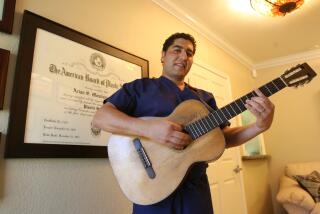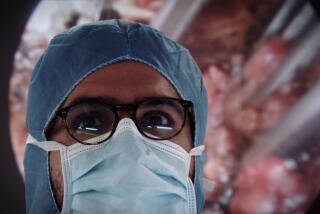Take-Home Videos Put Patients in the Spotlight
- Share via
Weak of stomach, beware. A new world has opened up for those who like to say “Let me tell you about my operation.” Now patients of some Southland surgeons can say, “Come on over and see my video.”
One surgeon, Dr. Norman Peterson, a Laguna Hills ophthalmologist, for the past year has been taping all his surgeries and giving the tapes free to patients as a way to “build satisfaction.” Most of the tapes show the doctor extracting a cataract and implanting an artificial lens in his patients’ eyes.
Party With Popcorn
“We kind of kid them and say ‘Invite your neighbors over and fix popcorn,’ ” said office manager Dona Van Houghton.
Assistants also select background music for the video from an eclectic collection that includes the “1812 Overture,” “La Traviata,” Michael Jackson’s “Off the Wall” and dance music from the big band era. The patients, under light sedation and local anesthesia for the operations, are conscious during surgery.
In the Laguna Hills community, which includes 20,000 retired residents of Leisure World, operations are a “top topic” of conversation, Van Houghton said. Word gets around quickly if an operation was “good, bad, or indifferent.” The videos are just one of several “internal” marketing practices of the Eye Surgery Center, Peterson said.
Margaret Sampson, 79, of Laguna Hills has a video of her cataract operation at Peterson’s Eye Surgery Center. But, she said, she has only watched it once.
“Once was quite enough,” said another patient, who asked not to be identified.
With the advent of more sophisticated and less expensive video equipment, video cameras in the operating room have become more commonplace. But most doctors, largely fearing malpractice suits, do not give patients videotapes of their own operations, said Dr. Michael Kennedy, a general surgeon and president of the Orange County Medical Assn. “You’d have to be very confident that you did good.”
Some Doctors Displeased
Some obstetricians are unhappy over fathers who want to videotape the birth of their children in the hospital, he said. “Some babies look blue at birth. It’s normal but some might misunderstand and make something of it if the baby doesn’t get into Harvard. That’s the kind of world we live in,” Kennedy said.
Another reason handing out tapes may not catch on is that most operations are still too gory for most people’s tastes, doctors said.
Some plastic surgeons do taping for “before” and “after” comparisons, Kennedy said. “But I’d think any patient seeing a movie of their face lift would throw up and run out of the room.”
Rick Williams, director of media services at UCI Medical Center, makes about 75 tapes a year for the hospital’s surgeons, psychologists and psychiatrists for legal, insurance or educational reasons. “If I walk into an operating room, they want to know who you are and who you’re working for before you point that camera,” he said.
Not only is there a risk of recording the off-color jokes, but also the offhand remarks. “Suppose they flub up and say, ‘Aw gee, I messed it up over here, let’s go around the other way’? “ said Williams.
But doctors like Peterson and Dr. Ralph Anderson, a San Diego ophthalmologist, believe there is little danger.
“In cataract surgery these day, chances are that nearly 100% do well,” said Anderson, who has been giving patient tapes away for five years. “If a problem should happen, and if your rapport with the patient is good and you’ve done everything that can be expected, it doesn’t matter whether it’s on tape. It may be even beneficial in a defense.”
Neither doctor said he had used the tapes in a malpractice defense.
Most tapes of operations are not complete enough to provide a legally accepted documentation, said Dr. Victor Strelzow, a surgeon who tapes a dozen operations a year at UCI Medical Center for teaching purposes. As surgical director of the UCI Medical Center Sleep Disorders Center, he tapes his techniques in hard-to-see places in the mouth and neck by wearing a camera strapped to his head like a miner’s lamp.
“With videotape, you’re looking in one place, but if the important information is a half inch away, you won’t get it on tape. . . . You can’t get everything,” Strelzow said. Taping is still too costly a luxury for him to give videos away to patients, he added.
Good Advertising
But competition among ophthalmologists is intense and tapes are good advertising, said Anderson. “It’s very effective. The patients just eat it up.”
The majority of cataract surgeons in San Diego use tapes as a marketing tool, he added. “Word soon gets out in the community what you’re doing and others follow.”
Besides the operation, Anderson’s tapes include a 10-minute “canned sales pitch” describing the nature of cataracts, the treatment and the alternatives. He also has a full-time employee who watches the operation over the monitor with the patients’ relatives and answers questions.
In addition to the equipment, the videos cost Peterson about $2,000 a year. As far as he knows, no new patients have come in as a result of the videos, but Anderson is certain the tapes have created new business for his practice.
Many people have a groundless fear that eye surgery is painful, Peterson said. The tapes “demystify the idea of surgery,” and the idea that a doctor would be comfortable enough to tape the surgery helps patients relax, he said. Also, he added, “We’re proud of our work. The tapes help give the patients a sense of what a marvelous process it is and what refinements have been brought about.”
Of Peterson’s 600 surgical patients per year, less than 10% say they are not interested in starring in a video of their operation, Van Houghton said. As a test, Peterson said he did not offer videos to seven patients who knew the operation had been taped. Five asked for the tapes immediately following the surgery and the other two came back later to request them, he said.
The office also provides a monitor in a special waiting room where friends and relatives can see the patient being rolled into the operating room, and then watch a close-up of the eye surgery as it’s being performed. Viewers are offered cheese and crackers and an information sheet explaining 18 steps of the surgery so they can follow along.
Watching His Mother
On a recent afternoon, Dan Sullivan of Playa del Rey sat in the room, listening to John Denver singing “Sun-shine on my shoul-ders makes me haaa-peee . . .” while he watched his mother, Amelia Sullivan, 89, being rolled in for surgery.
The scene was being recorded by a wall-mounted camera in the operating room, which holds two cameras, three television sets, a compact disc player and stereo system among the pumps, and an electrocardiograph.
Peterson, in blue scrub suit and mask, was getting ready, focusing and centering another 11-inch video camera attached to his microscope. A “state of the art” voice-activated camera, moved up and down, backwards and forwards at his command.
“Channel 2,” he said, directing his assistants to manually switch the source of the image from the wall-mounted unit to the microscope. Denver’s singing mingled with the electronic beep of Sullivan’s heart and the swooshing pump that powers an operating tool as the surgery began.
For the next 20 minutes, the image of an open eye filled the monitors. Small knives opened the membranes to expose the white, then sliced under and around the eye. A tube inserted underneath shattered the clouded lens and sucked it out. The artificial lens was put in place and the wound sewn shut with needle and nylon thread.
“Good baseball stitch,” Dan Sullivan said of the doctor’s technique as he watched in the anteroom.
‘A Cold Sweat’
Sullivan said that, at first, “I broke out in a cold sweat watching it. . . . You don’t like to see anyone you know cut on, especially your own mother.”
After the initial shock, he said he got used to viewing the operation. “It’s a fantastic idea. I’m sure my mother would like to see it. . . . My sisters will really enjoy looking at it. My wife will be disappointed she didn’t get to see it, so having the video will be terrific.”
Sullivan said he thought Denver’s ballads were not appropriate for surgery, but “at least it’s not organ music.”
The patients’ siblings, children and grandchildren like watching the tapes “for whatever reason,” office assistant Van Houghton said. “Some are thinking of going to medical school.”
Peterson also offers free transportation; after surgery he gives the patients a packet with instructions, medication, protective dark glasses and a Polaroid picture taken of themselves with the doctor. They receive a take-home catered dinner for two of teriyaki chicken, potato salad, muffins and chocolate cake. That night, Peterson personally calls them at home.
He said he also benefits from the tapes, sometimes borrowing them back to show at doctors’ meetings or to submit to the Video Journal of Ophthalmology, based in St. Louis.
But none of the possible returns explains why he started giving the tapes to patients, he said. “I just thought it was a nice idea.”
More to Read
Sign up for Essential California
The most important California stories and recommendations in your inbox every morning.
You may occasionally receive promotional content from the Los Angeles Times.













